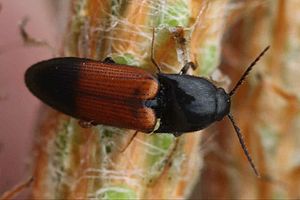Belted click beetle
| Belted click beetle | ||||||||||||
|---|---|---|---|---|---|---|---|---|---|---|---|---|

Belted click beetle ( Ampedus balteatus ) |
||||||||||||
| Systematics | ||||||||||||
|
||||||||||||
| Scientific name | ||||||||||||
| Ampedus balteatus | ||||||||||||
| ( Linnaeus , 1758) |
|
|
The Gegürtelte beetle ( Ampedus balteatus ) is a beetle from the family of beetles and the subfamily of Ampedinae. The wing-coverts of the black beetle are brownish-red or yellow-brown, the last third is usually blackened. It becomes 7.5 to 10 millimeters long.
The species is classified in the Red Lists of Rhineland-Palatinate as not endangered , in Schleswig-Holstein as endangered (category A.3 and 3).
Notes on the name
The species was already described by Linnaeus in 1758 in the famous tenth edition of his Systema naturae under the name Elater balteatus . Linné mentions in the short description Elytris antice dimidiato-rubris ( lat. Wing-coverts in front faintly red), in the longer description elytris bicoloribus e fulvo & nigro (lat. Wing-coverts two-colored yellow-red and black). It can therefore be assumed that he uses the species name balteātus (Latin for bordered, belted) to denote the impression caused by the coloring.
The generic name Ampēdus ( ancient Greek αμπηδάω αναπηδάω ampēdáō, anapēdáō , I jump up) means that the beetles can jump up from the supine position. Dejean is considered to be the author in 1833, when the name appears in an auction catalog. There it is noted that the name was taken from Megerle . However, the names in Megerle's auction catalogs are not recognized.
The genus Ampedus is represented in Europe with almost sixty species, all of which belong to the same subgenus. Worldwide, a distinction is made between three sub-genera, which comprise over a hundred species.
Description of the beetle
The pronotum pages are continuously fine margins when belted beetles, but the boundary runs like in many species of the family front down so he that close is no longer visible the head from above. On the underside of the body, the pronotum is fused with the front chest, only near the head is the fused seam (Prosternal seam) a little deepened to accommodate the antennae. The front chest is rounded at the front, drawn out in a long point at the back, which can snap into a corresponding groove in the middle chest. This quick mechanism enables the beetle to jump into the air from its supine position. The legs are weak, the tarsi all five-limbed.
In contrast to the subfamily Physorrhininae, which otherwise has similar characteristics, the third tarsal segment is not extended into a sole flap.
The rear hip, which connects to the rear of the rear chest, is hollowed out to partially accommodate the rear thighs. The part that is on the same level as the rear chest is called the thigh ceiling . Their shape is an important determinant. In the Ampedus genus , the thigh covers are wide on the inside, forming a corner before the abrupt narrowing to the outside. On the inner edge they have a blunt tooth pointing backwards (picture). About the inwardness of the eleven-membered probe before the eyes of the springs trim strip . This rim-shaped protrusion runs inwards and combines with the front strip on the other side to form an arched projection of the head (picture). Below that, the head drops vertically to the upper lip. The mouthparts point downwards.
Among the black click beetles with red wing-coverts, the belted click beetle is distinguished by a number of properties. Most noticeable is the blackening of the last third of the wing-coverts, which, however, may have gone out. The points on the disk of the pronotum are the same size and density everywhere. In addition to the side edge of the pronotum, the puncture is unabelled in the rear half, and in the front it can be nicked. The third antennae is not enlarged (sawn) like the fourth, but elongated and, like the second antennae, more shiny than the following. The hair is black on the upper side of the body and yellowish on the underside of the body.
Occurrence
The species occurs in northern and central Europe up to the Alps and France , in the Carpathians , Caucasus , Siberia , especially in areas with old pine stands .
Way of life
The species is mainly found in pine forests, but also on heather and moor. The beetles can be found on or under the bark or in rotting wood, mainly from conifers, but also from birch , oak and alder .
The larvae live in damp and rotten pine wood, on which they feed. The beetles are predatory.
literature
- Heinz Joy, Karl Wilhelm Harde, Gustav Adolf Lohse: The beetles of Central Europe . tape 6 : Diversicornia . Spectrum, Heidelberg 1979, ISBN 3-87263-027-X .
- Klaus Koch : The Beetles of Central Europe Ecology . 1st edition. tape 2 . Goecke & Evers, Krefeld 1989, ISBN 3-87263-040-7 . P. 61
Individual evidence
- ↑ Ampedus (Ampedus) balteatus in Fauna Europaea
- ↑ Red lists at BioNetworkX
- ↑ a b C.Linnaeus: Systema Naturae per Regna tria naturae, secundum classes, ordines, genera, species, cum characteribus, differentiis, synonymis, locis. Tomus I. Editio decima, reformata Stockholm 1758 First description page 409 | 405 No. 13
- ↑ Sigmund Schenkling: Explanation of the scientific beetle names (species)
- ↑ Sigmund Schenkling: Explanation of the scientific beetle names (genus)
- ↑ Catalog des coléoptères de la collection de M. Le comte Dejean Paris 1833 page 92
- ↑ IMKerzhner: JC Megerle's 1801–1805 Auction Catalogs of Insects porposed Suppression… Bulletin of zoological nomenclature Vol. 48 (3) September 1991 p. 206 [1]
- ↑ Ampedus Ampedus (subgenus) in Fauna Europaea. Retrieved March 21, 2013
- ↑ Subgenera of the genus Ampedus at BioLib
Web links
- Ampedus (Ampedus) balteatus at Fauna Europaea

